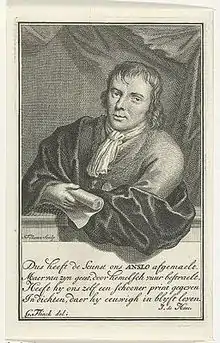Reyer Anslo
Reyer Anslo (1622 or 1626 – 16 May 1669) was a Dutch poet.
Reyer Anslo | |
|---|---|
 | |
| Born | 1626 |
| Died | 10 May 1669 |
| Citizenship | Netherlands |
| Occupation | poet, dramaturgy |
Life
Anslo was born at Amsterdam and brought up a Mennonite.[1] He was baptized in 1646. Early civic fame as a poet came to him in Amsterdam, when he was rewarded by his with a laurel crown and a silver dish for a poem in honour of the foundation stone of the new town hall in 1648.[2] In 1649 he travelled to Rome with Arnout Hellemans Hooft (1629-1680), the son of P.C. Hooft; they arrived in November 1651.[3] In December he was received into the Catholic Church, together with forty-three others, as is shown by manuscript records of the Society of Jesus (Lit. annuae Soc. Jes., in the Burgundian Library at Brussels, VI, No. 21818b fo 300, ao 1651). He proceeded to Rome, where he became secretary to Cardinal Luigi Capponi, and received from Pope Innocent X a gold medal for his poetical labours. In 1655 he was presented to Queen Christina of Sweden, to whom he dedicated new poems. A poem entitled De Zweedsche Pallas ("The Swedish Pallas"), brought him a golden chain. He died at Perugia.
Works
Anslo's collected works were published in 1713. They include a tragedy, "The Parisian Blood-Bridal" (De parysche bloed-bruiloff, 1649), dealing with the Massacre of St. Bartholomew. He wrote an epic on The Plague at Naples (1656).[4]
Notes
- His family originated from Christiania, now Oslo (Norway). His mother remarried in 1631.
- "K. ter Laan, Letterkundig woordenboek voor Noord en Zuid · dbnl". DBNL. Retrieved Sep 4, 2020.
- "Een naekt beeldt op een marmore matras seer schoon - Boeken - Verloren". Uitgeverij Verloren. Retrieved Sep 4, 2020.
- Chisholm, Hugh, ed. (1911). . Encyclopædia Britannica (11th ed.). Cambridge University Press.
References
- Attribution
 This article incorporates text from a publication now in the public domain: Herbermann, Charles, ed. (1913). "Reyer Anslo". Catholic Encyclopedia. New York: Robert Appleton Company. The entry cites:
This article incorporates text from a publication now in the public domain: Herbermann, Charles, ed. (1913). "Reyer Anslo". Catholic Encyclopedia. New York: Robert Appleton Company. The entry cites:
- Peter Paul Maria Alberdingk Thijm in Kirchenlexikon;
- ____, in the Dietsache Warande (Amsterdam);
- ____, Spiegel van Nederlandsche Letteren (Louvain, 1877, II, III).
External link
 Media related to Reyer Anslo at Wikimedia Commons
Media related to Reyer Anslo at Wikimedia Commons